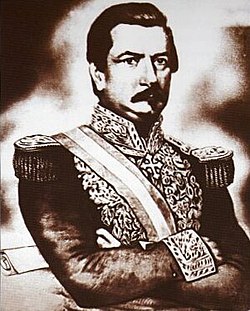Gerardo Barrios | |||||||||||||||||||||
|---|---|---|---|---|---|---|---|---|---|---|---|---|---|---|---|---|---|---|---|---|---|
 Portrait of Gerardo Barrios, 1861 | |||||||||||||||||||||
| 10th President of El Salvador | |||||||||||||||||||||
| In office 7 February 1861 – 26 October 1863 | |||||||||||||||||||||
| Vice President | José Félix Quirós | ||||||||||||||||||||
| Preceded by | José María Peralta (acting) | ||||||||||||||||||||
| Succeeded by | Francisco Dueñas (provisional) | ||||||||||||||||||||
| In office 12 March 1859 – 16 December 1860 Acting President until 1 February 1860 | |||||||||||||||||||||
| Preceded by | José María Peralta (acting) | ||||||||||||||||||||
| Succeeded by | José María Peralta (acting) | ||||||||||||||||||||
| In office 24 June 1858 – 18 September 1858 Acting President | |||||||||||||||||||||
| Preceded by | Miguel Santín del Castillo | ||||||||||||||||||||
| Succeeded by | Miguel Santín del Castillo | ||||||||||||||||||||
| Deputy of the Legislative Assembly | |||||||||||||||||||||
| In office 1858–18?? | |||||||||||||||||||||
| Constituency | San Miguel | ||||||||||||||||||||
| |||||||||||||||||||||
| Personal details | |||||||||||||||||||||
| Born | José Gerardo Barrios Espinoza September/October 1813 Cacahuatique or La Poza de la Juana, New Spain | ||||||||||||||||||||
| Died | 29 August 1865 (aged 51) San Salvador, El Salvador | ||||||||||||||||||||
| Cause of death | Execution by firing squad | ||||||||||||||||||||
| Nationality | Salvadoran | ||||||||||||||||||||
| Political party | Liberal | ||||||||||||||||||||
| Spouse |
Adelaida Guzmán Saldós
(m. 1843) | ||||||||||||||||||||
| Relatives | Joaquín Eufrasio Guzmán (father-in-law) José Trinidad Cabañas (brother-in-law) | ||||||||||||||||||||
| Occupation | Military officer, politician | ||||||||||||||||||||
| Military service | |||||||||||||||||||||
| Allegiance | |||||||||||||||||||||
| Branch/service | Central American Army Salvadoran Army | ||||||||||||||||||||
| Years of service | 1828–1863 | ||||||||||||||||||||
| Rank | Captain General | ||||||||||||||||||||
| Battles/wars | |||||||||||||||||||||
José Gerardo Barrios Espinoza (September/October 1813 – 29 August 1865) was a Salvadoran military officer and politician who served as president of El Salvador on three occasions between June 1858 and his overthrow in October 1863.
Born in 1813, Barrios was taught various fields of education by his grandfather and a family friend, who also instilled in him his liberal ideals he held throughout his life. As a teenager, Barrios fought for the Federal Republic of Central America under Francisco Morazán from the late-1820s to the early-1840s. He continued his military career in El Salvador where he fought during Malespín's War in the mid-1840s, the Guatemalan–Salvadoran War in the early-1850s, and the Filibuster War in the mid-1850s.
As minister of internal affairs in 1857, Barrios attempted a coup d'état against President Rafael Campo but failed. Despite his attempted coup, he was appointed as minister of external affairs in January 1858 by President Miguel Santín del Castillo. When Santín left the presidency due to illness on 24 June 1858, Barrios assumed office as provisional president. Santín resumed his presidency on 17 September 1858 and appointed Barrios as minister of internal and external affairs three days later.
In January 1859, Santín and Barrios both resigned from their positions and Joaquín Eufrasio Guzmán, Barrios' father-in-law, became president. Eventually, Guzmán resigned and was replaced by José María Peralta on 15 February 1859, who himself resigned on 12 March 1859 and was replaced by Barrios. Barrios ran unopposed and won the 1859 presidential election, and began a six-yer term on 1 February 1860. During his presidency, Barrios worked to improve the country's education system and reduce the influence of the Catholic Church.
In 1863, conservatives joined a Guatemalan invasion of El Salvador to depose Barrios. Although Barrios defeated Guatemalan soldiers under Rafael Carrera at the Battle of Coatepeque in February 1863, the Guatemalans eventually prevailed and forced Barrios to flee the country on 26 October 1863 after the Siege of San Salvador. In his place, the Guatemalans installed Francisco Dueñas as provisional president. Barrios attempted to return to power in May 1865, but his ship was forced to dock in Nicaragua where he was arrested. He was extradited to El Salvador in August 1865 where he was court-martialed and sentenced to death. Barrios was executed by a firing squad on 29 August 1865.
Barrios is considered to be a national hero and has many locations and institutions named after him.